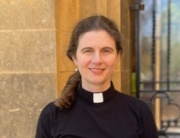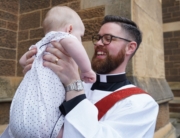Love Bade Me Welcome – a Lenten sermon series by The Rev’d Canon Jenny Wilson

Lent 2: Love Bade Me Welcome
– A Spirituality of a Cathedral
The Choir (number 2 of 4)
17 March 2019
The Rev’d Canon Jenny Wilson
In the name of God, creating, redeeming, sanctifying… Amen.
Last Sunday, in the first of our evensong sermon series looking at the spirituality of our Cathedral in this year of its 150th anniversary, we pondered the Nave – we found there a place of welcome and also a place of journey, we found there a place where our value in God’s eyes is affirmed and a place where we offer to one another God’s peace, we found there an open door that sends us out into the world to share God’s love in generosity.
This sermon series is woven with George Herbert’s poem Love Bade Me Welcome and we closed last week’s sermon with the first verse; tonight we will begin also with the second:
Love bade me welcome: yet my soul drew back,
Guilty of dust and sin.
But quick-eyed Love, observing me grow slack
From my first entrance in,
Drew nearer to me, sweetly questioning
If I lacked anything.
“A guest,” I answered, “worthy to be here”:
Love said, “You shall be he.”
“I, the unkind, ungrateful? Ah, my dear,
I cannot look on thee.”
Love took my hand, and smiling did reply,
“Who made the eyes but I?”
God’s welcome of us and forgiveness for us, God’s longing to give us life in places of fear and illness and death is at the heart of the Christian story. But we do draw back. For we are so very aware of the guilt that mars us, we are indeed guilty of dust and sin. And we may know this well, or it may be an unease, a doubt, a fear, that causes this hesitation. But quick eyed love, indeed, draws nearer.
This drawing back can at times be as a result of a numbness, a shock. All who have witnessed or heard of the events in Christchurch, New Zealand, in recent days will know this shock, will know horror, will know a sense of helplessness in the face of ruthless violence, will be left wondering about a world at once so beautiful and yet so cruel. How might it be that the “quick-eyed Love” of God draws near to those gathered in cathedrals and churches and mosques and halls across the world, when such grief is at hand?
In this, the second sermon in our evensong series about the spirituality of our Cathedral we will explore ways in which God, described by George Herbert as “quick-eyed Love”, draws nearer, in which our “God made eyes” might look upon God in this place. This evening we will reflect on The Choir, the place in the Cathedral where the choir sings, where the organ is played and where the scriptures are read, and we will ponder the way in which God reaches out to us not only in word and music but also in glass and wood and stone.
This evening and each evening in these first four weeks on Lent the choir has sung as our introit Locus Iste by Anton Bruckner. The choir have sung this piece in many places; it is their “party piece”. I have heard them sing it on a hill overlooking Salisbury cathedral, and I have heard them sing it in the Catacombs in Rome. Wherever they travel they sing it, but this night they sang it in their home, “The Choir”. This evening in the second of this series, we will spend time pondering the Choir. By this we mean not our beloved and greatly talented group of Cathedral singers but the space in which they sing.
For the Choir is the place in the Cathedral where the ministry of music takes place. And, perhaps, when our souls draw back, in guilt or in shock and grief, when we hesitate in response to Love’s welcome, one way that God reaches out to us, draws nearer to us is through music. The music of our Cathedral is based on cathedral music across the world and especially in England where the monastic tradition is followed – as we see in our choir – with monks sitting opposite one another, chanting psalms and canticles in alternate verses from one side to another. The music of the choir is upheld and enhanced by the music of the organ whose console and pipes rise up above the place of the choir. One of the great celebrations for this organ in this Cathedral at this particular time is the restoration that has taken place over the past two years, the organ with its shining new casework a symbol in music of the blessing it is when a community of people gather together to support a project dear to their heart.
When we allow ourselves to be touched by music we approach it with humility, with vulnerability, we allow it to reach us, to possibly even transform us; we allow music to open our eyes to the beauty and the struggle of life, to the possibility of God and love and redemption.
One contemporary composer said the following about the place of music in the struggle of faith.” Consciously I am certainly an atheist, but I do not say it out loud because if I look at Bach I cannot be an atheist. Then I have to accept the way he believed. His music never stops praying. How can I get closer if I look at him from the outside? I do not believe in the gospels in a literal fashion, but a Bach fugue has the crucifixion in it – as the nails are being driven in. In music I am always looking for the hammering of the nails….that is a dual vision. My brain rejects it all. But my brain isn’t worth much.” [1]
When our souls draw back, music prays for us, it seems.
God reaches us in other ways in a Cathedral. The building itself is a work of art. Its towers reaching for the heavens, its high roof, the long view which can be seen so well from the gallery all impress on us that, to quote a chorister who once spoke to me about faith, “When I come into the Cathedral I know there is something bigger than me and my problems.” Or, as Michael Mayne, former Dean of Westminster Abbey, wrote in Pray, Love, Remember, the book from which the idea for this sermon series came, “I never fail to be moved by how affected [visitors] are by the atmosphere in this historic, holy and storied space. Although I use words with which to tell its story, it is invariably the space that speaks.”[2]
The space that speaks of God.
Returning to The Choir, we find ourselves drawn in different ways into the story of God. At one end of The Choir, where the long line of the building meets the second of the transepts which cross at right angles, high up we see the Lantern, symbol of light overcoming darkness, imagery for Jesus found particularly in the Gospel of John. Below the lantern we find the Cathedra, from which the Cathedral gets its name, the seat of teaching of the Bishop, the one who is responsible for upholding the faith of the Church.
Situated at the other end of The Choir, within easy view of the congregation, we find a lectern, literally a place where words are read, our lectern in the shape of an eagle, the bird who would carry the word of God to the whole world. The story of God, read from Old Testament and New, is heard day by day, Sunday by Sunday. Sermons are preached from it, prayers and hymns based on it, psalms sung from it. The Cathedral’s vocation is to help those who enter its doors to know that their story belongs in the great story of God, told in scripture.
The stone building is woven with other forms of art, art which tells God’s story in ways other than words. The stained glass windows, placed in every wall of the Cathedral, speak of our story of faith and the characters of our faith. As we enter the nave, we see in the lower windows kings and queens, missionaries, monks and bishops. If we lift our eyes we see the clerestory windows created by Cedar Prest. Struck by a Cathedral that seemed so deeply connected to England and to have little connection with the land on which it was built, she designed a set of windows using the image of the vine from John 15 that connect the images of the Australian landscape with images from scripture. Glass, again, imaging our story woven into God’s story. The windows of our Cathedral span in style the full 150 years of the building’s history, the most modern being the Magdalene window above the St Barnabas door, a window which portrays a resurrection scene that celebrates the ministry of women.
In a Cathedral dedicated to Saint Peter, we find many references to our dearly loved and yet utterly human saint. Perhaps my favourite windows are in the Lady Chapel, one group of which represent one of the most poignant of all the gospel stories. The scene is a charcoal fire. Jesus, risen from the dead, is questioning Peter three times about his love for him, forgiving three times the denials that so tore them both apart at the time of Jesus’ trial. The weaving of Jesus’ words into the windows help those gazing at them to enter powerfully into the scene. Love is bidding us welcome again. Our souls, like Peter’s drawing back, only to have love reaching out again with forgiveness.
Love bade me welcome. In our Cathedral we find ourselves made welcome in so many ways. This evening we have begun our reflections in the Choir remembering that God reaches out to us in music, music which also helps us offer our prayers in reply to God. Music prays, remember. God invites us in as we gaze on lovingly crafted wood and glass and stone. God reaches out to us in the words of scripture, scripture that tells the story of God inviting us into the story that is our home.
This night we sit in our Cathedral, conscious of the fact that the human heart is capable of great hatred as well as great love. We sit knowing that when that great hatred overpowers a person, unimaginable violence and suffering can take place. And then, strangely, mercifully, we witness responses of great love and solidarity and compassion. How might a Cathedral enfold us as we struggle to sit with such truths? Our story is of one who knew these truths, embraced these truths for us, that we might know that even in the darkest of human experiences we are not alone. And that through God’s embrace of hatred by Jesus, love will never be extinguished, never be overcome. And, yet, perhaps, in the end, what a cathedral gives us is itself. Perhaps, as Michael Mayne, former Dean of Westminster Abbey, wrote, it is the space that speaks. Perhaps when suffering is so very great, it is the building and the silence that holds us in God’s precious welcome.
[1] John Eliot Gardiner in his book on Bach, Bach, Music the Castle of Heaven, quoted this statement from the contemporary German composer Gyorgy Kurtag.
[2] Michael Mayne Love, Pray, Remember p 52.





